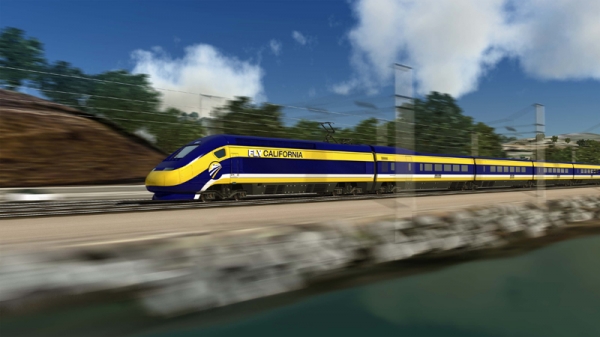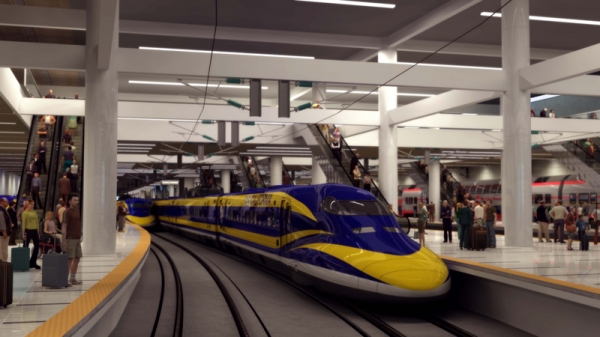California's contentious drive to build a high-speed-rail system between San Francisco and Los Angeles sped ahead last week, when state lawmakers approved funding for the first construction phase. But the $68 billion project still has to pass through a gauntlet of legal, financial and political obstacles before it becomes reality.
The most immediate threat comes from litigation, of which there has been no shortage. Palo Alto, Menlo Park and Atherton remain involved in a lawsuit against the California High-Speed Rail Authority, the agency charged with building the system. The lawsuit, which claims that the authority's environmental analysis relies on erroneous ridership projections, will be the subject of a settlement conference in Sacramento Monday morning, July 16, said Palo Alto City Councilman Larry Klein, who chairs the city's Rail Committee.
Even if the rail authority settles the Peninsula lawsuit, it will still face fierce opposition from Central Valley, where construction is set to begin. A coalition of agencies, including the Madera County and Merced County farm bureaus and the Chowchilla Water District, filed a lawsuit last month, arguing that the rail authority "due to a myriad of analytical deficiencies, failed to disclose and analyze the full scope and severity of impacts."
The litigation could continue as the rail authority unveils its "project-level" Environmental Impact Reports, which pertain to specific segments of the San Francisco-to-Los Angeles line and have a higher level of engineering and design specificity. Klein said the city will consider in the coming months whether it should file or join any other lawsuits against the rail authority.
Then there are the political hurdles, including bids to have California voters weigh in a second time on the high-speed-rail project. Although a bill by State Sen. Doug LaMalfa, R-Richvale, met a quick death on the Senate floor last week, a group of opponents led by former U.S. Rep. George Radanovich is pursuing a similar citizen initiative. In its petition, the group argues that the state "cannot afford to pay for a high-speed train system that will cost more than $100 billion at a time when teachers and police are being laid off, prisoners are being released from prisons, and taxpayers are being asked to dig deeper into their own pockets to pay for basic services."
Meanwhile, city officials and rail watchdogs are still analyzing the text of Senate Bill 1029, which lawmakers released in the waning hours of July 3 and which the 40-member state Senate approved by a single vote on July 6. Elizabeth Alexis, co-founder of the Palo Alto-based group Californians Advocating Responsible Rail Design, said the group remains concerned about where the rest of the funds for the system will come from.
"When you look at full costs and benefits in Central Valley -- it's very little positive transportation value unless you spend another $30 billion dollars," Alexis said. "The concern is that this will act as a sponge for all available money that can go to other worthy projects."
The specific language of the budget-trailer bill only adds to the anxiety. For example, the bill allocates $1.1 billion for a "blended system" on the Peninsula -- a design under which high-speed rail and Caltrain can share two tracks between San Jose and San Francisco. But the bill also states that the $1.1 billion can be transferred to other items, including construction in the Central Valley (known in the bill as Item 2665-306-6043), with approval from the state Department of Finance.
"It looks like accounting minutiae, but if you translate it, it means that with one signature from a governor appointee, the money for Caltrain can be moved to the Central Valley project," Alexis said.
"The first time you read a bill it seems very clear to you," she added. "It's only on the 12th reading of the bill that you really understand all the loopholes."
Palo Alto officials have other concerns about the specific bill, including the fact that the language specifies that "any funds appropriated in this item" shall be used for a blended system and not to "expand the blended system to a dedicated four-track system." City officials argued that this language doesn't offer sufficient protection to ensure that the rail authority would pursue a blended system rather than the deeply unpopular four-track alternative. They called for language specifying that "funding in subsequent years may also not be used for a four-track system on the Peninsula."
Despite major reservations from all Republicans and some Democrats in the Senate, the appropriation bill received 21 votes, the minimum needed for advancement. The bill allocates $2.7 billion from the Proposition 1A bond to launch construction on the system's opening segment in the Central Valley and another $1.1 billion to support the "blended system" on the Peninsula. The state Assembly had voted 51-27 on July 5 to approve the bill.
Much like in the Assembly, members of the Senate lined up largely along party lines, with Democrats supporting and Republicans opposing the bill. But some Senators, including Joe Simitian, D-Palo Alto, and Alan Lowenthal, D-Long Beach, crossed the party lines and voted against the project. Both of them have been heavily involved in oversight of the project since 2008, when voters approved a $9.95 billion bond for high-speed rail.
Supporters of the appropriation bill, led by Senate President Pro Tem Darrell Steinberg, argued that the rail project is badly needed to create jobs and improve California's transportation infrastructure.
"In this era of term limits, how many chances do we have to vote for something this important and long-lasting?" Steinberg asked his colleagues at the beginning of the debate. "How many chances do we have to vote for something that will inject a colossal stimulus into today's economy while looking at the future far beyond our days in this house?"
Simitian rejected this logic and focused on the particulars of the bill. He cited the fact that the rail authority has a leadership structure riddled with vacancies and that the bulk of the funding in the bill would go toward a 130-mile track in the Central Valley. He also noted that the bill fails to answer the critical question of how the rest of the $68 billion system would be funded and cited criticism from a variety of nonpartisan agencies, including the Legislative Analyst's Office and the Office of the State Auditor.
Simitian also alluded to the Field Poll conducted last week, which showed that the controversial project could derail the tax measure that Gov. Jerry Brown plans to bring to the voters in November. Though 54 percent of the survey respondents said they support Brown's proposal, a third of those surveyed said they would be less likely to vote in favor of the measure if the legislature were to fund high-speed rail.
Simitian cited the souring public opinion for the project in explaining his vote. By chasing the $3.3 billion in federal funding for high-speed rail, Simitian said, the legislature is risking a $40 billion hole in the budget that lawmakers would have to fill if Brown's measure fails.
"How are we going to feel if we wake up on Wednesday after Election Day and look at the trigger cuts -- the $40 billion that will have to be pulled painfully from the budget -- from schools, colleges, universities, health, welfare and public safety?" Simitian said. "We may not think that's the way it ought to be but the hard practical reality is that that's the way the folks back home are thinking about these tradeoffs."
In the Assembly, both Jerry Hill and Rich Gordon voted to support the appropriation bill. Gordon said at the Assembly hearing that he went through a "period of doubt" on the high-speed-rail project but that his "faith has been restored" by the rail authority's embracing of the blended approach, which he had championed along with Simitian and U.S. Rep. Anna Eshoo.
"I do think that this is a part and parcel of our future, and I think the projects that are defined in this legislation also stand alone on their own for the moment, as we move in the future toward full implementation of high-speed rail," Gordon said.




Comments
Shoreline West
on Jul 17, 2012 at 8:48 am
on Jul 17, 2012 at 8:48 am
THE SCAM THAT WOULDN'T DIE
Shoreline West
on Jul 17, 2012 at 2:21 pm
on Jul 17, 2012 at 2:21 pm
I want it to go through, because it WILL be a failure. Then we have a billions and billions and billions of dollars told-ya-so trump card.
Whisman Station
on Jul 17, 2012 at 6:14 pm
on Jul 17, 2012 at 6:14 pm
Let's see.
Caltrain is near bankruptcy, dependent on taxes.
We pay tax money for B.A.R.T., but do not have a station for the system.
There are planned extensions for B.A.R.T. to locations that do not pay into the system.
If Caltrain and B.A.R.T. are not paying their way, what hope does a taxpayer supported system have?
The cost estimates for high speed rail risen past the speed of reality.
Rex Manor
on Jul 18, 2012 at 7:59 am
on Jul 18, 2012 at 7:59 am
I want to commend Gennady's well-researched, well-presented and impartial article. Good information on a vitally important subject. (Just choose carefully between "like" and "as," as in the adverbial—not adjectival—usage "like in the assembly".)